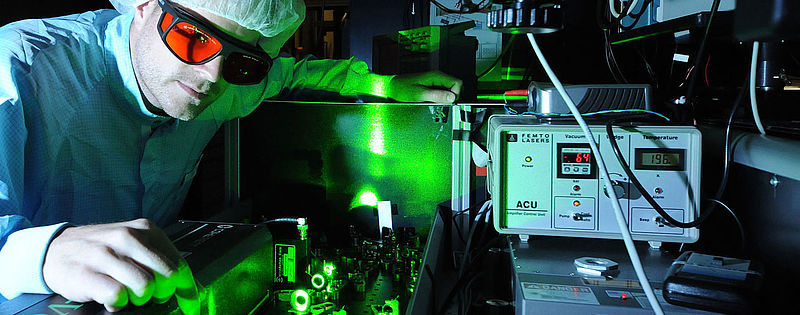featured publications – A team in the Laboratory for Attosecond Physics (LAP) at the Max-Planck-Institute of Quantum Optics has taken another step toward the achievement of complete control over the waveform of pulsed laser light. Together with colleagues based at LMU and the Technische Universität München (TUM), they have constructed a detector which provides a detailed picture of the waveforms of laser pulses that last for a few femtoseconds (1 fs = 10-15 seconds). Unlike conventional gas-phase detectors, this one is made of glass, and measures the flow of electric current between two electrodes that is generated when the electromagnetic field associated with the laser pulse impinges on the glass. The researchers can then deduce the precise waveform of the pulse from the properties of the induced current. Knowledge of the exact waveform of the femtosecond pulse in turn makes it possible to reproducibly generate light flashes that are a thousand times shorter – lasting only for attoseconds (1 as = 10-18 sec) – and can be used to study ultrafast processes at the molecular and atomic levels (Nature Photonics, DOI:10.1038/nphoton.2013.348, 12 January 2014).
Modern mode-locked lasers are capable of producing extremely brief light flashes that last for only a few femtoseconds (1 fs is one-millionth of a billionth of a second). With durations of as little as 2.5 fs, such pulses correspond very few oscillations of the electromagnetic field, indeed to only 1 to 2 complete cycles, which are however preceded and followed by waves of lower amplitude that are rapidly attenuated. In laser physics it is often important to know more about the precise form of the high-amplitude oscillations, because this tells one the shape of the electromagnetic fields and allows them to be utilized in an optimal manner to probe ultrashort processes that occur at the level of molecules and atoms.
A team led by Prof. Ferenc Krausz and including his doctoral student Tim Paasch-Colberg has now developed a glass-based detector that allows one to accurately determine the form of the light waves that make up an individual femtosecond pulse. In the course of experiments performed over the past several years, physicists in the group have learned that when pulsed high-intensity laser light impinges on glass, it induces measurable amounts of electric current in the material (Nature, 3 January 2013). Krausz and his colleagues have now found that the direction of flow of the current generated by an incident femtosecond pulse is sensitively dependent on the exact form of its wave packet.
In order to calibrate the new glass detector, the researchers coupled their system with a conventional instrument used to measure waveforms of light. Since the energy associated with the laser pulse is sufficient to liberate bound electrons from atoms of a noble gas such as xenon, the »classical« detector measures the currents caused by the motions of these free electrons. But there is a catch – the measurements must be done in a high vacuum. By comparing the currents induced n the new solid-state detector with the data obtained using the conventional apparatus, the team was able to characterize the performance of their new glass-based set-up, so that it can now be used as a reliable phase detector for few-cycle femtosecond laser pulses. The new instrument enormously simplifies measurements in the domain of ultrafast physical processes, because one can dispense with the use of cumbersome vacuum chambers. Moreover, in its practical application the technique is much more straightforward than the methods available for the mapping of waveforms hitherto.
If the precise waveform of the femtosecond laser pulse is known, it becomes possible to reproducibly generate stable trains of ultrashort attosecond light flashes, each one a thousand times shorter than the pulse used to induce them. The composition of the attosecond flashes is in turn highly dependent on the exact shape of the femtosecond pulses. Attosecond flashes can be used to »photograph« the motions of electrons in atoms or molecules. In order to obtain high-resolution images, the length of the flashes must be tuned to take account of the material one wants to investigate.
Highly sensitive and reliable measurements of physical processes at the level of the microcosmos with the aid of single attosecond light flashes of known shape should become easier to perform because, thanks to the new glass-based phase detector, the source of the energy to drive them – the waveform of the laser pulses – can now be controlled much more easily than before.
